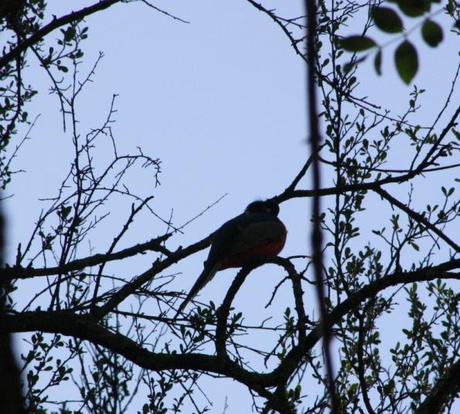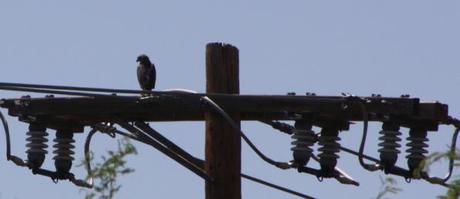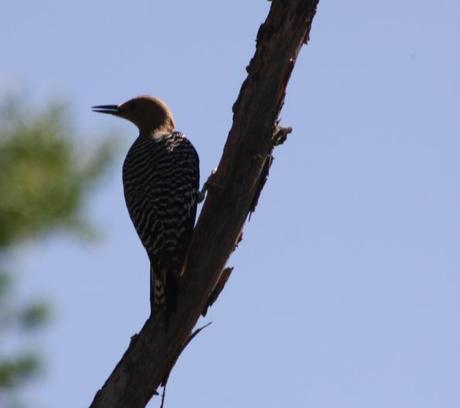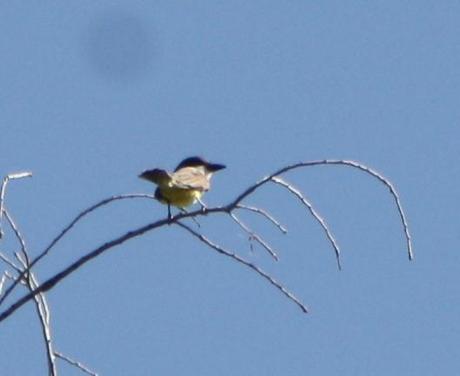After a great first day, or half day, of birding in SEAZ, we spent the majority of our second day (5-11-2012) in Madera Canyon. At first light, we broke camp after a successful night of sleeping on Proctor Rd. While breaking camp, birds were singing all around including Black-headed Grosbeaks, Canyon Towhees, and Northern Cardinals. After we finished breaking camp and chugging energy drinks, we stopped by the restroom area to take a quick jaunt on the trails. There, we observed Cassin’s Kingbirds, Swainson’s Thrushes, Botteri’s Sparrows, and heard a singing Scott’s Oriole among others.
The next spot on our list for the day was Florida Wash. Florida Wash is a mixture of habitats including mesquite and grasslands. We birded the wash for a little over an hour and came up with 29 species. Highlights from the wash include Rufous-crowned, Rufous-winged, and Botteri’s Sparrows, and Pyrrhuloxia.

Canyon Towhee at Florida Wash on 5-11-2012
From the wash, we headed to Upper Madera Canyon in hopes of finding hummingbirds, trogons, and a rarity or two. We birded the upper canyon for over four hours and totaled only 26 species. Every birder we stumbled upon in the canyon that day said the birding has been extremely slow all morning. We had the same thoughts as we hiked and birded the Carrie Nation Trail, but we did get good looks at very good birds including an Elegant Trogon, Magnificent and Broad-tailed Hummingbirds, Plumbeous, Hutton’s, and Warbling Vireos, Grace’s and Black-throated Gray Warblers, Painted Redstarts, and Yellow-eyed Juncos. The upper canyon was filled with lifers for me!

Elegant Trogon at Upper Madera Canyon on 5-11-2012
After hiking around for four hours, we ventured back down canyon to Madera Kubo Bed & Breakfast to try for the White-eared Hummingbird and Lauren’s state Rose-breasted Grosbeak. We struck out on both target birds, but tallied 23 species in the hour and a half we birded there. We observed five species of hummingbird including Magnificent, Black-chinned, Anna’s, Broad-billed, and Blue-throated. We searched the area for Flame-colored Tanagers as this was an area they bred in previous years, but had no success. The tanagers were reported in the area the next day though, bummer.
We stopped by the Santa Rita Lodge afterwards to check the feeders and for a cold beverage, but did not have anything noteworthy.Our next stop was the Rio Rico Pond. Here, we tallied 23 species in ten minutes with having decent, but distant looks at Black-bellied Whistling-Ducks, Mexican Ducks, and a beautiful Gray Hawk.

Gray Hawk at Rio Rico Pond on 5-11-2012
After our quick stop at the Rio Rico Pond, we headed straight for the Paton’s Yard to peep the Violet-crowned Hummingbirds. We birded the yard for forty minutes and observed 25 species, including a lone Violet-crowned Hummingbird as the major highlight of the sit. Also, we almost fell asleep on the benches at the Paton’s. We needed a major caffeine break.After gorging ourselves in snacks and energy drinks, we headed down the road to the Sonoita Creek Preserve. Here our target was Thick-billed Kingbird, which gave us great looks during our half hour of birding the preserve.

Gila Woodpecker at the Paton’s Yard on 5-11-2012

Thick-billed Kingbird at the Sonoita Creek Preserve on 5-11-2012
After leaving the preserve, we drove to Carr Canyon. En route up canyon, we obtained great looks at three beautiful Band-tailed Pigeons and a Greater Pewee, both lifers for me. We camped at Reef Campground and birded while we cooked dinner and set up camp. Just from the campground, we observed 15 species. The main highlight was having great looks at two Buff-breasted Flycatchers!We ate dinner and did a night walk further up canyon to listen for owls and poor-wills, but had no luck. That ended day two of our trip to SEAZ.

Band-tailed Pigeon in Carr Canyon on 5-11-2012
Other posts about our trip:
Birding Southeast Arizona–Day 1
Check back for highlights of Day 3!

